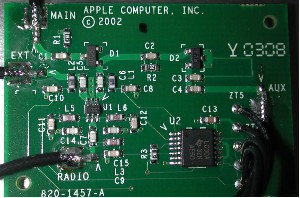Airport Base Station Extreme Revealed and Extended!
The Airport Extreme is a logical evolution from the previous two generations as described here. Thanks to two readers, Matthias Pfaff and James Shields, I am now able to show off the interior of the base station. You can observe an even deeper Dissection of a Airport Extreme on a later page that I developed.
The exterior of the ABS "Extreme" is similar to that of a "Snow" base station. The only obvious optical hints (besides the name sticker) are the different ports on the backside. As you probably know, the ABS 3.0 comes in two configurations:
- The $199 MSRP unit has a 802.11g access point and 10/100 WAN and LAN ports.
- The $249 MSRP unit has all of the above plus a dialup modem and external antenna connector.
Evidently, Apple is trying to value-price their ABS', making the non-modem unit more price-competitive with respect to the rest of the market. None of the first three generations of ABS' require a modem to function - remove the modem daughtercard and the ABS will still function as a access point without a dialup option.
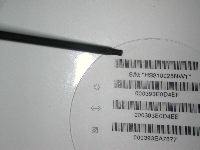
So, let's see what happens when you try to open up a "Extreme" base station. You'll need a Torx T-8 screwdriver to remove the three Torx screws holding the plastic exterior shell together as well as a small phillips screwdriver to remove the bottom plastic shell from the inner shell. The Phillips screw can be found under the sticker on the bottom of the ABS as I show on the right. I suppose this is Apple's way of figuring out who has meddled with a base station, so consider that before you open a ABS (i.e. your warranty will be void).
Comparison of Airport Extreme Base Stations:
Modem Version ($250)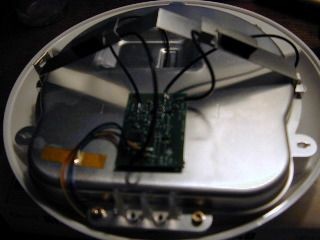 (picture credit: James Shields) The Airport Extreme models that feature an external antenna have a rather large circuit board that controls the antenna functions. Several multi-colored wires snake up from below to add power and to control this circuit board. |
Regular Version ($199)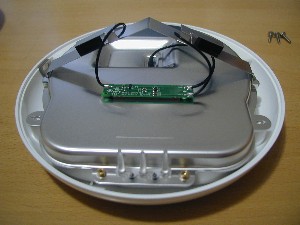 (picture credit: Sascha Großkopf) As with the "Snow" base stations, the V-shaped stamped metal piece is a dipole antenna that has two wires that attach it to the circuit board. The conductor in the very center of either picture runs to the Airport card inside the metal enclosure (see dip under center of dipole antenna). |
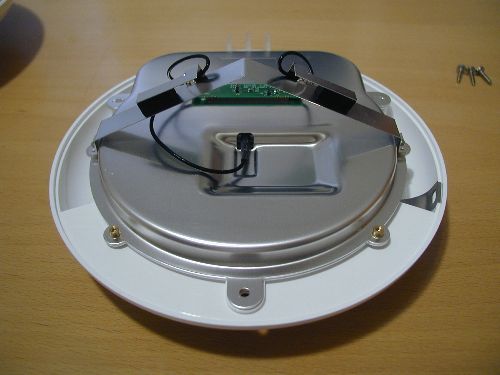 The fantastic picture to the right by Sascha Großkopf shows the antenna plug and V-shaped dipole antenna from the other side of the ABS. Antenna kits or pigtails that fit the "Snow" base station without modification will also fit the Airport Extreme (at least according to several reader reports). Apparently, the metal enclosure of the "Extreme" base station is very close to that of the "Snow" base station.
The fantastic picture to the right by Sascha Großkopf shows the antenna plug and V-shaped dipole antenna from the other side of the ABS. Antenna kits or pigtails that fit the "Snow" base station without modification will also fit the Airport Extreme (at least according to several reader reports). Apparently, the metal enclosure of the "Extreme" base station is very close to that of the "Snow" base station.
Note the recurring use of straight axial plugs on the part of Apple. These plugs are almost impossible to come by on the free market.
What we do know is that the venerable Lucent Extender Antenna plug will not fit without the removal of the plastic jacket. Just as on the "Snow" base station, the plastics on the right angle plug interfere with the metal enclosure of the ABS. Below is a picture from James Shields that shows the two plugs side-by-side.
 As this picture from James Shields shows, Apple is using an axial plug (right) to connect the antenna coax wire to the external board.
As this picture from James Shields shows, Apple is using an axial plug (right) to connect the antenna coax wire to the external board.
The Lucent "Extender Antenna" plug can be seen to left with its characteristic white wire. The thick plastic exterior and shape of the plug does not accommodate the shape the metal enclosure (just above it in this picture).
You can see the three torx screws to open the case to the left, along with the T-8 screw-bit that James Shields used.
Airport Extreme Base Station Antenna Boards:
Modem Version ($250)(Click on either image to enlarge it)The external antenna circuit board is very interesting. Unlike the "Snow" version, this board is actually powered by the ABS as evidenced by wiring coming into it from the bottom right of this picture. This board may act as a amplifier and as a switching device, though there are differing perspectives regarding the actual function of the antenna board. The coax wire entering the board at "Radio" is coming from the Airport card via the axial connector shown above. The "Main" and "Aux" wires are used for the built-in dipole antenna (right and left side). The "Ext" wire connects the board to the external antenna plug. It looks like that plug has a op-amp in its signal path. |
Regular Version ($199)
The "Snow"-like Antenna board in Extreme Base Stations that do not have an external antenna plug is much smaller. This board may features some sort of amplification circuitry. My guess it is powered via the coaxial antenna cable. Some cable-TV amplifiers work along the same means with a DC injector at one end and amplifiers elsewhere as needed. Here is a neat link to perspectives regarding the function of this board. On this board, the signal enters via the "COM" in the top right of the board. The "Main" and the "Aux" then carry the signal to the two sides of the Dipole antenna. The black coaxial wires require some very delicate soldering as the diameter is tiny and each wire requires two solder operations - one for the external braided shielding, another for the inner conductor. Retrofitting something on the board itself is more than a bit tricky! |
Hence the trouble that many folks have had attaching external antennas to "Extreme" base stations. Even if either board does not amplify the signal at all, the new antenna must have at least a net gain of 2.1dbi to equal the antenna inside the "Extreme" ABS. That pretty much eliminates most pre-fab antennas with MC-Card connectors that have 5 foot long cables (i.e. 2.5db loss there) and a gain of less than 5dbi. If the circuit incorporates an amplifier (as I suspect it does) then the gain would have to be even higher to result in an improvement.
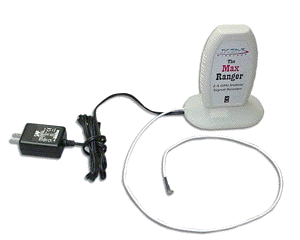
In the meantime, I have found one product that looks very promising and that can easily attached to the MC-Card plug found inside the "Extreme" ABS. It's called the YDI Max-Ranger antenna and you can buy it at Fab-Corp. The reason it looks promising is that this unit is a Automatic Gain Amplifier and antenna that boosts signal output to 23dbm (i.e. 300mW). Attach the MC-Card plug to your ABS, insert the power supply, and you should be good to go.
Unfortunately, the price is sufficiently high where buying a second ABS is not out of the question... and probably a better idea, if you can take advantage of WDS or have a ethernet port to plug it into.
Another option is to place a second base station remotely and power it over the ethernet wire. Due to its 5VDC power supply, the "Extreme" ABS requires a more complicated solution than the previous two ABS generations. You can buy one at Macwireless for $70. With the PoE injector, you only need to run an ethernet wire to where the ABS needs to be - no local electrical outlet is required. Thus, a PoE injector is a great way to optimally place your base station within your house. It works for locations in the basement, attic, or even the garden shed. Just remember to shield the ABS from the elements.
Since I have no experience with the YDI Max-Ranger, I would appreciate any feedback you may have with its use. I'll try and update the pages here ASAP afterwards.
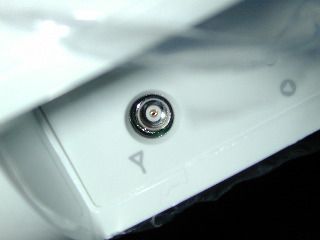 Thanks to James Shields, here is a picture of the external antenna plug on a Airport Extreme base station with that feature. I have gotten three reports that this is a MCX type plug, so that question is now resolved.
Thanks to James Shields, here is a picture of the external antenna plug on a Airport Extreme base station with that feature. I have gotten three reports that this is a MCX type plug, so that question is now resolved.
My recommendation for owners of AEBS' with a external connector:
For the folks with an AEBS that has an external antenna connector, there are now several choices. Dr. Bott sells the $100 3.5dbi gain Omni-directional ExtendAir Omni or the $150 Directional Extendair Direct. Either unit looks beautiful, though they are pricey. Part of the value-pricing is derived by the custom circuitry installed in these antennas. A standard MCX pigtail and generic antenna combination will not work unless you add a Type 3 or Type 4 Lightning Protector - see more below.
Hyperlinktech also offers a number of external antennas for the AEBS, though be advised that their minimum order quantities and nonexistent return policies are obnoxious. Here are a couple of antennas they carry: The $40 5dbi omni-directional Hypergain, the $80 8dbi omni-directional Range-Doubler, or the $40 8dbi directional 8dbi Flat Patch. Both the ExtendAir and HyperGain antennas have 5 foot long antenna cables, resulting in 2.5 db of cable loss, so their benefit will be greatly diminished.
As stated above, the your best bet may be to attach the YDI Max-Ranger directly to the MC-Card outlet instead of going with an external antenna. However, the $150 price point is very close to the price of a new AEBS. Since AEBS' can use WDS to talk to each other, you may be better off buying a second base station instead. Your coverage is almost guaranteed to be better.
My recommendation for those who did not buy a AEBS with a external connector:
The most promising extension product appears to be the YDI Max-Ranger antenna from Fab-Corp for $150. This integrated amplifier (23dbm) and antenna features a short antenna cable and should increase the range of your base station regardless of the output at the MC-Card plug. Thus, it is very easy to hook up and should be foolproof.
However, the $150 price point is very close to the price of a new AEBS. Since AEBS' can use WDS to talk to each other, you may be better off buying a second base station instead. Your coverage is almost guaranteed to be better.
Anyway, leave the top off the AEBS if you want the Extreme base station to benefit from cooler operating conditions. For a more elegant solution, you can dremmel a small cut into the plastic enclosure to accommodate the signal cable. Either way: Smile, for you have saved yourself at least $50 over buying a "official" solution. The folks who bought a AEBS for the modem can still retrofit the MC-Card antenna without any issues.
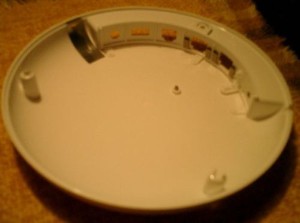 As this picture from Matthias Pfaff shows, the "Extreme" base station does not have the same "kidney piece" as the "Snow" base station that preceded it. All holes for connectors are molded right into the bottom saucer half. Thus, retrofitting a cable will pretty much necessitate drilling a hole into the exterior shell unless you want to leave the top off.
As this picture from Matthias Pfaff shows, the "Extreme" base station does not have the same "kidney piece" as the "Snow" base station that preceded it. All holes for connectors are molded right into the bottom saucer half. Thus, retrofitting a cable will pretty much necessitate drilling a hole into the exterior shell unless you want to leave the top off.
Observations for die-hard tinkerers and hackers:
The switching circuit apparently senses the resistance of any antenna attached to the plug. If the resistance is above 50 Ohms, the internal dipole antenna is "turned off" and all power flows to just the external plug.
One reader managed to trick his AEBS into acknowledging the external antenna by booting the AEBS while holding a 51 Ohm resistor across the right leads on the circuit board. This is a bit riskier than I care for, but the AEBS retains this "external antenna" setting in the Admin Utility for as long as it hasn't been rebooted. Now you can attach a MCX-connector external antenna of choice.
Another reader mentioned that using a lightning arrestor of type 3 or 4 would do the trick. He kindly provided this PDF to explain the different lightning-arrestor topologies. This reader also confirmed that the above connector has standard polarity. I am told there are several lightning arrestors that make the AEBS work with external antennas:
- Proxim Part Number 848274163 (~$90 @ Hyperlinktech, CNET).
- RFLinx Part Number 2400 LAR (~$50 @ RFLinx).
Both units have two N-Female Connectors. Thus, you'd have to use two pigtails before you can attach it to an antenna (MCX to N-Male, N-Male to N-Male). This lightning arrestor hack is really only for those who want to install outdoor systems or those seeking to use amplifiers. Anyway, that's it for now. If anyone has some additional information, pictures, etc. they'd like to share, I'd really appreciate it. Many thanks again to Matthias Pfaff, James Shields, Sascha Großkopf, and those who want to remain nameless for their help. You can click on any highlighted name to send an e-mail.



